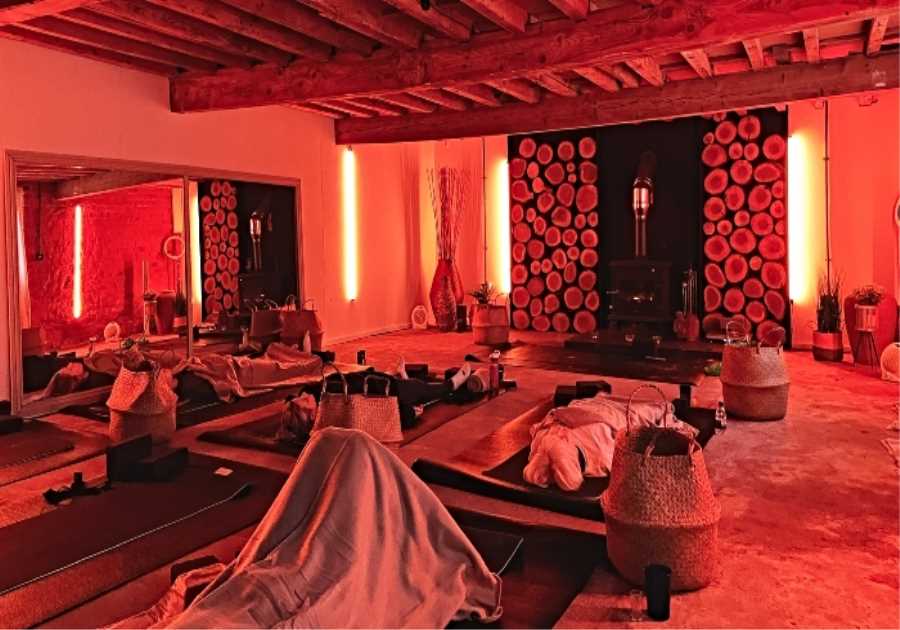Photo by Jernej Graj
We each have an inner compass. We need not be a meditator to access this inner guide to deep knowing. I sometimes call it bone knowledge—the knowledge deep in our bones of who we truly are and what we need to do. Call it instinct or intuition or presence, it is deeper than the fight, flight, or freeze reflex. When not facing those, we know very swiftly what to do. We cultivate our inner compass both in solitude and in company over our lifetime. Furthermore, it is a tool with which we were born. But whenever the scales tip; if depression, trauma, anxiety, or PTSD become too overwhelming, we cannot necessarily access our inner compass, and this may lead to a breakdown or a sense of being lost. And so cultivating the inner compass through quiet, solitude, and rest, or through playful, invigorating activities is crucial.
In solo or small group retreats, we have the opportunity to get down to the essentials of body, speech, and mind. For example, in a recent small group retreat I led, we pared down the use of our devices and the internet to just a few minutes a day, if at all. We limited speaking and interacting in ordinary ways as the five days progressed. We gradually removed several layers of our usual habits. This served to honor our hearts and minds as well as our bodies into an awakened, sensitized state, with a deeper relaxation of our usual anxieties, neuroses, and thought patterns.

Photo by Ashley Batz
I had come into the retreat with many stress factors, yet I quickly dropped in, partially due to the grace of the group context and their compassion. By the end of the five days, I was ready to stay and continue to practice for weeks, if not months, this simplified living in the forest, far from the city and the concerns of multiple jobs and responsibilities. This honoring of the senses—including the sixth sense of consciousness—persisted when I left retreat to stay with friends. One might think such a retreat could produce a blissful or spaced-out state of being, but it was quite the contrary. During the retreat, we applied levels of renunciation, one by one: removal or reduction of media input, internet use, accessing social media, texting, and phone calls, the city atmosphere, traffic, and mental activity from ordinary conversation. We simplified our diet and daily schedule to reduce unnecessary visual, auditory, and mental inputs.
With Buddhist vows, we renounce idle chatter, the chit-chat I refer to as discursion (discursive thought excursions), an outer aspect of nam tok in Tibetan—also translated as “mental experiences.” Nam tok is the whole inner world of projections based on misapprehensions of our true nature: “We are in a cocoon of self-centered distorted emotions such as fear, insecurity, lack of self-esteem, self-pity mind, conceitedness, inflated opinion of ourselves, and so on.”* We further reify this with outer interactions, thus fortifying our false beliefs, not to mention producing further karma. If, instead, we relax our usual modes of relating and soften our mind-states, we return to at least the outer borders of our inherently true nature, free from the stains of ego-grasping.

Photo by Joey Huang
The desire for renunciation and the simple joys of being in retreat, silence, and solitude are not diametrically opposed to engaged Buddhism or active meditation, or even to an “ordinary” secular perspective. Think of the Minimalists or Marie Kondo,** strategizing to have people realize their deeper values and priorities which underly the capitalistic striving that leaves many of us sick at heart, captured by material debt and relational deprivation.
Nourishment was the topic of our recent retreat, which might also seem opposed to renunciation, if you compare it with ascetic life in a gompa or zendo. However, one can glean nourishment from meditation by being still and letting go of movement, and also gain as much from movement with awareness, especially conscious movement that nourishes joints, bodily systems, and functions. The Buddha taught about body, speech, and mind. The body cannot be negated for extended periods without detrimental results. So nourishment in the context of practice means engaging the body in movement as well as in the relative stillness of sitting.

Photo by Mark Olsen
Nourishment is also derived from engaging in selfless service. It is a natural next step, after experiencing the joys of retreat and having the leisure to meditate, for the wish to benefit others to spring forth. We do not need to divorce ourselves from the woes of the world. Engaged Buddhism or meditation-in-action is not inherently different than being in the mode of retreat. Awareness and activity can be interwoven seamlessly, such as the great Tibetan yogi Shabkar Tsodruk Rangdrol (1781–1851) relates, when we perceive our body as the retreat hut:
In the retreat hut that is my own body
I sweep away the dirt. . .
My retreat helper is emptiness.***
Although this may connote sweeping away the dirt in a solitary hut, clearing the way for one’s own awakening, it may also be to sweep for others, that they too may be free from the debris of unawareness and suffering.

Photo by Rob Mullaly
We can always be in retreat to some degree, no matter where we are. Our limbs, voice, senses, and awareness, even our intelligence (ego basis) can be used as extensions of the deep inner quiet we cultivate in retreat; the homecoming to our inner compass. This quiet is not contrived but something to be uncovered, reclaimed. The quiet that reconnects us to that inner knowing, which never falters, over more than one lifetime, even when we superficially forget. Then we extend outward toward ourselves suffering beings in need of care and compassion. Discerning wisdom helps us to engage with the ordinary world in ways that diminish violence and increase harmony and well-being.
Like the taijitu (yin-yang) symbol, we develop a balance of activity and non-activity. The counterpoint to renunciation is embracing. I like the word embracement, to embrace and draw close to us those things that nourish and enliven our spirit. I think of this as coming back to one’s senses, literally; the senses of taste, touch, smell, sight, hearing, and consciousness. Simplifying is not merely an act of negation, but of acceptance and welcoming in those fundamental human experiences that do nourish us, while renouncing those that do not.

Photo by Kiel Jacob
Renunciation need not be strong, deprived, or punishing. Rather, it is a tool we apply to our practice and our lives to enhance awareness, compassion, wisdom, and a willingness to let go. For let us not forget that as meditators, we are all practicing on this path, as my Lama used to say: “To die well.” Before that point arrives, we can live more simply and help others to do the same.
* Nam-tok: The hallucinatory bubble (FPMT)
** The Minimalists, Learn KonMari
*** In the retreat hut that is my own body (Poetry Chaikhana)
Related features from BDG
Uncertainty, Insecurity, and Instability
mourning
We’ve Turned Another Page
The Cloud Is Not Lost – In Honor of Thich Nhất Hạnh
Retreating into the World: the Ultimate Spiritual Practice
Bringing Awareness Practice from Retreat into the World






